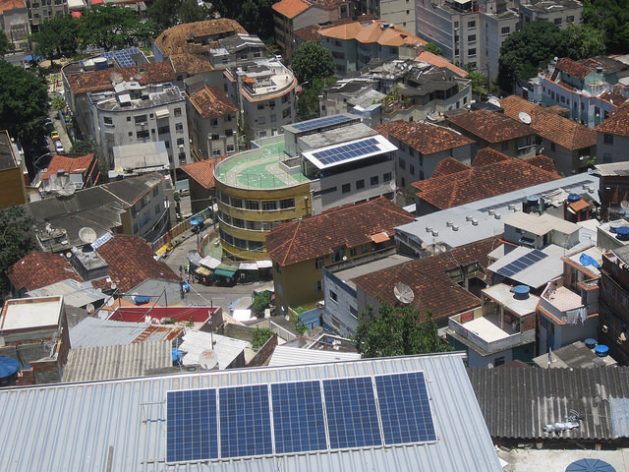Solar Energy Begins to Light Up Favelas in Rio de Janeiro

RÍO DE JANEIRO, Jan 22 (IPS) - "We can't work just to pay the electric bill," complained José Hilario dos Santos, president of the Residents Association of Morro de Santa Marta, a favela or shantytown embedded in Botafogo, a traditional middle-class neighborhood in Rio de Janeiro.
The high cost of electricity in the favela is due to consumption estimates made by Light, the local electricity distributor, based on telemetry, without reading the meters in each home, Santos believes.
"The bill is high even when you're not home, when you're traveling," he lamented.
The steady years-long rise in electricity has turned solar energy into a general desire, especially among the poor in the favelas, who account for nearly a quarter of the 6.6 million inhabitants of Rio de Janeiro proper, because the electric bill absorbs a large proportion of their income.
At least 15 public institutions in Santa Marta already have solar installations that lower their energy costs, thanks to Insolar, a "social business" company active in the neighborhood since 2015.
Four daycare centres, churches, the Residents Association, a music school and the local samba school now have solar power systems, with the support of Anglo-Dutch oil giant Shell.
Now the idea is to extend the initiative to 30 businesses on the "morro" or hill where the Santa Marta favela is located. In addition, Insolar is seeking funding to install pilot systems in 14 other favelas in Rio de Janeiro, to expand solar energy, for which there is growing demand in these areas, said Henrique Drumond, the company's founder.
"Our goal is to democratise solar energy," he explained. "We are doing it together with the local residents, involving them in the whole process, training local labour," he told IPS, which made several tours of Santa Marta and other favelas to talk with residents about the arrival of solar power in their lives and their economies.
For further information read Solar Energy Drives Social Development in Brazil's Favelas
© Inter Press Service (2019) — All Rights Reserved. Original source: Inter Press Service
Where next?
Browse related news topics:
Read the latest news stories:
- Looking beyond GDP to reach the Sustainable Development Goals Saturday, March 29, 2025
- UN chief strongly condemns killing of Kenyan peacekeeper in Central African Republic Saturday, March 29, 2025
- Myanmar quake: More than 1,600 reported killed, as UN aid operation supports rescue efforts Saturday, March 29, 2025
- Water and Food Security in Europe and Central Asia: A Shared Challenge for a Sustainable and Just Future Friday, March 28, 2025
- Latin America & the Caribbean in 2024: Renewable Energy and Early Warning Systems Offer Hope Amid Climate Extremes Friday, March 28, 2025
- Marley, Music, Morris, Life: A Photo Voyage in Paris Friday, March 28, 2025
- The Giant Plastic Tap: How art fights plastic pollution Friday, March 28, 2025
- UNICEF Report Warns of Rising Rates of Child Mortality without Proper Funding Friday, March 28, 2025
- Building Resilience in Least Developed Countries – A Pathway to Sustainable Transformation Friday, March 28, 2025
- Haiti reaches ‘yet another crisis point’ as gangs tighten their grip Friday, March 28, 2025